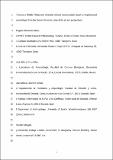Files in this item
Towards a Middle Pleistocene terrestrial climate reconstruction based on herpetofaunal assemblages from the Iberian Peninsula : state of the art and perspectives
Item metadata
| dc.contributor.author | Blain, Hugues-Alexandre | |
| dc.contributor.author | Cruz Silva, José Alberto | |
| dc.contributor.author | Jiménez Arenas, Juan Manuel | |
| dc.contributor.author | Margari, Vasiliki | |
| dc.contributor.author | Roucoux, Katherine | |
| dc.date.accessioned | 2019-05-20T23:38:17Z | |
| dc.date.available | 2019-05-20T23:38:17Z | |
| dc.date.issued | 2018-07-01 | |
| dc.identifier | 253147428 | |
| dc.identifier | c692a833-b2c5-434c-bb45-26615c5e3de9 | |
| dc.identifier | 85047148989 | |
| dc.identifier | 000437363000012 | |
| dc.identifier.citation | Blain , H-A , Cruz Silva , J A , Jiménez Arenas , J M , Margari , V & Roucoux , K 2018 , ' Towards a Middle Pleistocene terrestrial climate reconstruction based on herpetofaunal assemblages from the Iberian Peninsula : state of the art and perspectives ' , Quaternary Science Reviews , vol. 191 , pp. 167-188 . https://doi.org/10.1016/j.quascirev.2018.04.019 | en |
| dc.identifier.issn | 0277-3791 | |
| dc.identifier.other | RIS: urn:695710C79B441AF54376B355F92D75E6 | |
| dc.identifier.uri | https://hdl.handle.net/10023/17733 | |
| dc.description | This paper has been mainly funded by the University of Reading and also by projects CGL2016-80000-P (Spanish Ministry of Economy and Competitiveness) and 2017SGR-859 (Generalitat de Catalunya). | en |
| dc.description.abstract | The pattern of the varying climatic conditions in southern Europe over the last million years is well known from isotope studies on deep-ocean sediment cores and the long pollen records that have been produced for lacustrine and marine sedimentary sequences from Greece, Italy and the Iberian margin. However, although relative glacial and interglacial intensities are well studied, there are still few proxies that permit quantitative terrestrial temperature and precipitation reconstruction. In this context, fauna-based climate reconstructions based on evidence preserved in archaeological or palaeontological sites are of great interest, even if they only document short windows of that climate variability, because (a) they provide a range of temperature and precipitation estimates that are understandable in comparison with present climate; (b) they may allow the testing of predicted temperature changes under scenarios of future climate change; and (c) quantitative temperature and precipitation estimates for past glacials and interglacials for specific regions/latitudes can help to understand their effects on flora, fauna and hominids, as they are directly associated with those cultural and/or biological events. Moreover such reconstructions can bring further arguments to the discussion about important climatic events like the Mid-Bruhnes Event, a climatic transition between moderate warmths and greater warmths during interglacials. In this paper we review a decade of amphibian- and reptile-based climate reconstructions carried out for the Iberian Peninsula using the Mutual Ecogeographic Range method in order to present a regional synthesis from MIS 22 to MIS 6, discuss the climate pattern in relation to the Mid-Bruhnes Event and the thermal amplitude suggested by these estimates and finally to identify the chronological gaps that have still to be investigated. | |
| dc.format.extent | 22 | |
| dc.format.extent | 1171306 | |
| dc.language.iso | eng | |
| dc.relation.ispartof | Quaternary Science Reviews | en |
| dc.subject | Vertebrates as climate proxy | en |
| dc.subject | Amphibian | en |
| dc.subject | Reptile | en |
| dc.subject | Mutual Ecogeographic Range | en |
| dc.subject | Middle Pleistocene | en |
| dc.subject | South-Western Mediterranean | en |
| dc.subject | GE Environmental Sciences | en |
| dc.subject | G Geography (General) | en |
| dc.subject | SDG 13 - Climate Action | en |
| dc.subject | SDG 14 - Life Below Water | en |
| dc.subject.lcc | GE | en |
| dc.subject.lcc | G1 | en |
| dc.title | Towards a Middle Pleistocene terrestrial climate reconstruction based on herpetofaunal assemblages from the Iberian Peninsula : state of the art and perspectives | en |
| dc.type | Journal item | en |
| dc.contributor.institution | University of St Andrews. School of Geography & Sustainable Development | en |
| dc.identifier.doi | 10.1016/j.quascirev.2018.04.019 | |
| dc.description.status | Peer reviewed | en |
| dc.date.embargoedUntil | 2019-05-21 |
This item appears in the following Collection(s)
Items in the St Andrews Research Repository are protected by copyright, with all rights reserved, unless otherwise indicated.

